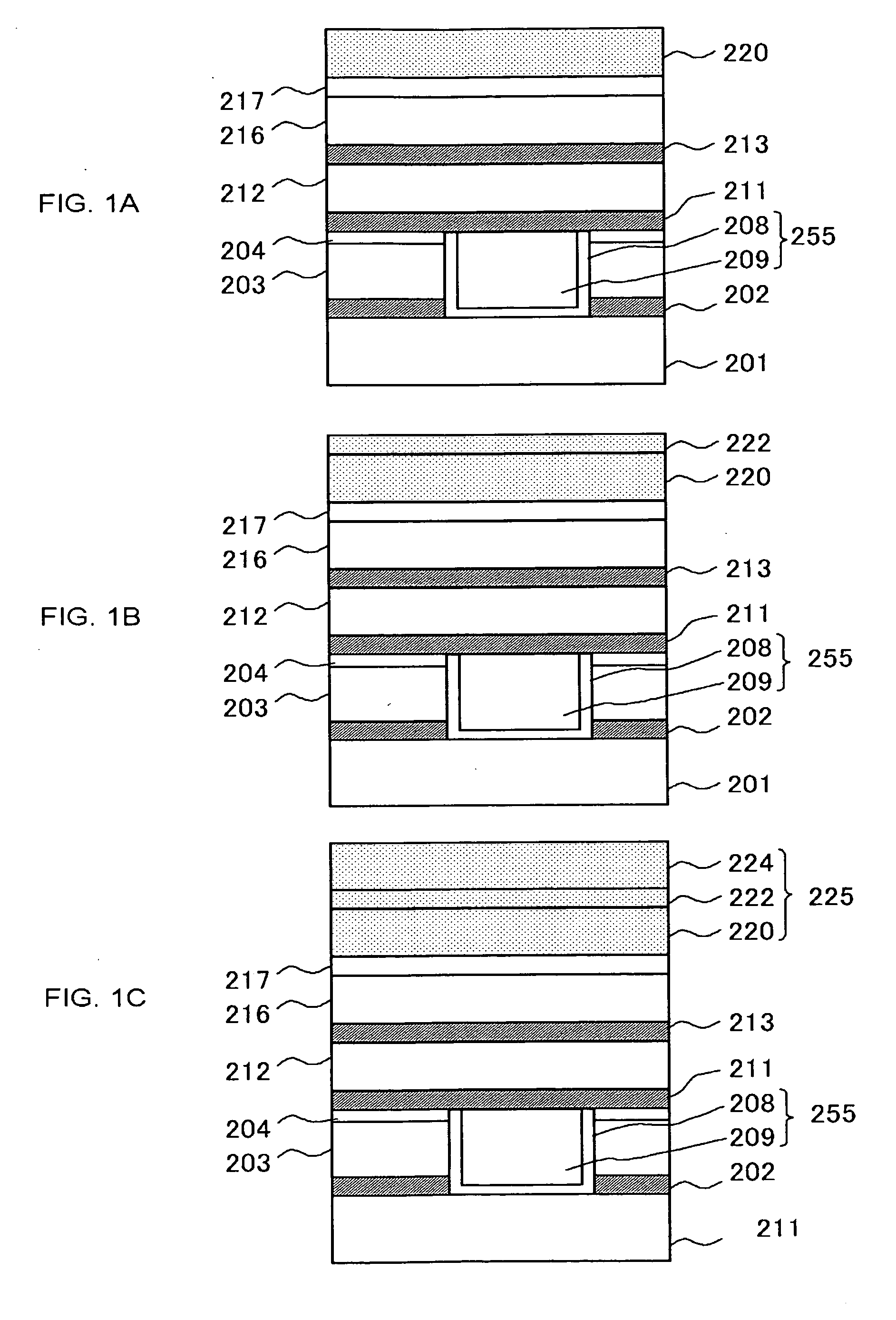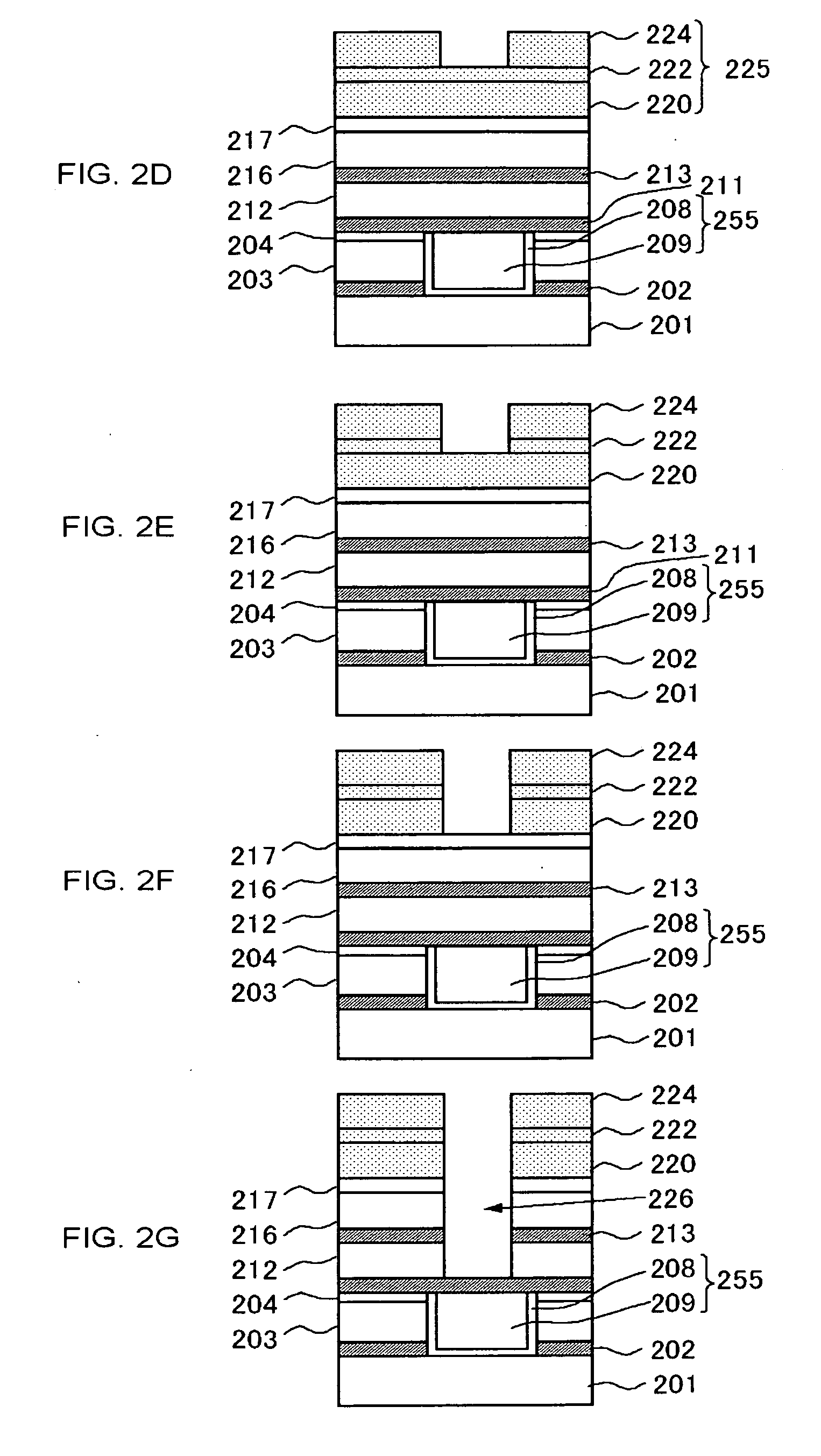Method of fabricating a semiconductor device
a semiconductor and semiconductor layer technology, applied in semiconductor/solid-state device manufacturing, basic electric elements, electric devices, etc., can solve the problems of easy deformation of si—chsub>3/sub>bonds, easy deformation of sog layers, and increased hygroscopicity of sog layers
- Summary
- Abstract
- Description
- Claims
- Application Information
AI Technical Summary
Benefits of technology
Problems solved by technology
Method used
Image
Examples
first embodiment
[0037]FIGS. 1A to 4L are step-wise sectional views showing procedures for fabricating a semiconductor device 200 according to the embodiment of the present invention.
[0038] This embodiment will describe an exemplary case where the present invention is applied to formation of a multi-layered wiring structure based on the dual-damascene process. The description herein will be made on a method of forming interconnects / wirings and vias by so-called, via-first process.
[0039] Procedures up to formation of a multi-layered wiring structure shown in FIG. 1A will be described. First, on an underlying insulating film 201 formed on a semiconductor substrate (not shown), an etching stopper film 202, a first interlayer dielectric film 203, and a first protective film 204 are sequentially stacked. The etching stopper film 202 is typically composed of a SiC film or a SiCN film.
[0040] The first interlayer dielectric film 203 can be configured using low-dielectric-constant materials such as polyhy...
second embodiment
[0062]FIG. 5 and FIG. 6 are structural drawings respectively showing the semiconductor device 200 according to the embodiment of the present invention. Detailed structure of the lower layers under the three-layered resist film 235 herein is not shown, simply referring to as an object-to-be-etched 229.
[0063] As shown in FIG. 5, the three-layered resist film 235 may also be configured as having an anti-reflection film 244 between the third resist film 230 and the intermediate film 232. The anti-reflection film 244 herein may be configured typically using SiON or SiOC. For an exemplary case where the anti-reflection film 244 is configured using SiON, SiON can be formed using SiH4 and N2O gases at 200° C. or below in a parallel-plate-type plasma CVD apparatus. The anti-reflection film 244 is preferably formed in the same apparatus in which the intermediate film 232 is formed. Enrichment of the Si composition of the anti-reflection film 244 can increase the attenuation coefficient of li...
example 1
[0067] Structural changes in a TEOS-SiO2 film, a SiH4—SiO2 film, and a SOG film before and after ashing were investigated. The individual films were prepared as follows.
i) TEOS-SiO2 Film
[0068] A mixed gas of TEOS and O2 (ratio of flow rate of 1:10) was used as a film forming gas, and the film was formed by the two-frequency plasma CVD process at 200° C. under a reduced pressure of approximately 3 Torr. Output power was adjusted to approximately 100 W for the higher frequency (13.56 MHz), and at approximately 200 W for the lower frequency (approximately 500 kHz).
ii) SiH4—SiO2 Film
[0069] The film was formed by the CVD process at 200° C., using a mixed gas of SiH4 and N2O (ratio of flow rate of 1:20), under a reduced pressure of approximately 3 Torr.
iii) SOG Film
[0070] A chemical liquid of SOG was dropped through a coater, sintered at approximately 200° C. on a hot plate, to thereby form the film.
[0071] Three thus-prepared films were subjected to O2 ashing at approximately 25...
PUM
 Login to View More
Login to View More Abstract
Description
Claims
Application Information
 Login to View More
Login to View More - R&D
- Intellectual Property
- Life Sciences
- Materials
- Tech Scout
- Unparalleled Data Quality
- Higher Quality Content
- 60% Fewer Hallucinations
Browse by: Latest US Patents, China's latest patents, Technical Efficacy Thesaurus, Application Domain, Technology Topic, Popular Technical Reports.
© 2025 PatSnap. All rights reserved.Legal|Privacy policy|Modern Slavery Act Transparency Statement|Sitemap|About US| Contact US: help@patsnap.com



